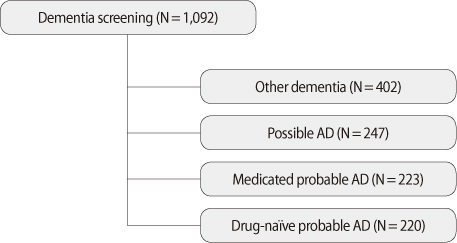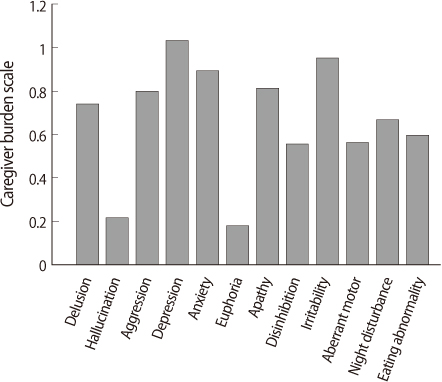Clinical Characteristics of Behavioral and Psychological Symptoms in Patients with Drug-naive Alzheimer's Disease
- Affiliations
-
- 1Department of Neurology, Hyoja Geriatric Hospital, Yongin, Korea. kwakdr@gmail.com
- 2Department of Neurology, Seoul Veterans Hospital, Seoul, Korea.
- 3Seoul National University College of Medicine, Seoul, Korea.
- KMID: 2222352
- DOI: http://doi.org/10.12779/dnd.2012.11.3.87
Abstract
- BACKGROUND
Behavioral and psychological symptoms of dementia (BPSD) are less well-defined aspects of Alzheimer's disease (AD). We designed this study to explore the followings: 1) the clinical profiles of BPSD 2) the clustered-groups domains of the Korean-Neuropsychiatric Inventory (K-NPI) assessment of BPSD 3) the clinical characteristics of the clustered-groups of BPSD in patients with drug-naive probable AD.
METHODS
Descriptive and cluster analyses of the 12 K-NPI domains were done in 220 patients with drug-naive probable AD. After clustering these domains, characteristics of these positive symptoms clustered-group of patients were compared with the negative symptoms groups of patients.
RESULTS
The mean Korean-Mini Mental Status Examination (K-MMSE), Clinical Dementia Rating (CDR) scale, and K-NPI scores were 15.0, 1.6, and 14.2, respectively. The CDR and K-MMSE scores correlated with total K-NPI scores, and depression was the most common symptom. According to cluster analysis, five major clusters were identified. Using the associated neuropsychological dysfunctions, characteristics of each group were defined.
CONCLUSIONS
This study identified the clustered-domains for K-NPI, and suggested the possible anatomical substrates for these groups in drug-naive AD patients. These attempts may clarify the complex and bizarre behavioral and psychological symptoms as more neurologically relevant symptoms.
Keyword
Figure
Cited by 6 articles
-
Depression in Alzheimer's Disease
Yong Tae Kwak, YoungSoon Yang, Min-Seong Koo
Dement Neurocogn Disord. 2014;13(2):27-36. doi: 10.12779/dnd.2014.13.2.27.Delusions in Alzheimer's Disease
Yong Tae Kwak, YoungSoon Yang, Min-Seong Koo
Dement Neurocogn Disord. 2014;13(3):63-73. doi: 10.12779/dnd.2014.13.3.63.Neuropsychological Characteristics of Wandering in Patients with Drug-naïve Alzheimer's Disease
YoungSoon Yang, Inha Hwang, Yong Tae Kwak
Dement Neurocogn Disord. 2014;13(3):74-78. doi: 10.12779/dnd.2014.13.3.74.Neuropsychological Characteristics of Wandering in Patients with Drug-naïve Alzheimer's Disease
YoungSoon Yang, Inha Hwang, Yong Tae Kwak
Dement Neurocogn Disord. 2014;13(3):74-78. doi: 10.12779/dnd.2014.13.3.74.Wandering in Dementia
Yong Tae Kwak, YoungSoon Yang, Min-Seong Koo
Dement Neurocogn Disord. 2015;14(3):99-105. doi: 10.12779/dnd.2015.14.3.99.Anxiety in Dementia
Yong Tae Kwak, YoungSoon Yang, Min-Seong Koo
Dement Neurocogn Disord. 2017;16(2):33-39. doi: 10.12779/dnd.2017.16.2.33.
Reference
-
1. Aalten P, de Vugt ME, Lousberg R, Korten E, Jaspers N, Senden B, et al. Behavioral problems in dementia: a factor analysis of the neuropsychiatric inventory. Dement Geriatr Cogn Disord. 2003. 15:99–105.
Article2. Steinberg M, Tschanz JT, Corcoran C, Steffens DC, Norton MC, Lyketsos CG, et al. The persistence of neuropsychiatric symptoms in dementia: the Cache County Study. Int J Geriatr Psychiatry. 2004. 19:19–26.
Article3. Matsui T, Nakaaki S, Murata Y, Sato J, Shinagawa Y, Tatsumi H, et al. Determinants of the quality of life in Alzheimer's disease patients as assessed by the Japanese version of the Quality of Life-Alzheimer's disease scale. Dement Geriatr Cogn Disord. 2006. 21:182–191.
Article4. Cummings JL, Mega M, Gray K, Rosenberg-Thompson S, Carusi DA, Gornbein J. The Neuropsychiatric Inventory: comprehensive assessment of psychopathology in dementia. Neurology. 1994. 44:2308–2314.
Article5. Frisoni GB, Rozzini L, Gozzetti A, Binetti G, Zanetti O, Bianchetti A, et al. Behavioral syndromes in Alzheimer's disease: description and correlates. Dement Geriatr Cogn Disord. 1999. 10:130–138.
Article6. Lyketsos CG, Breitner JC, Rabins PV. An evidence-based proposal for the classification of neuropsychiatric disturbance in Alzheimer's disease. Int J Geriatr Psychiatry. 2001. 16:1037–1342.
Article7. Mirakhur A, Craig D, Hart DJ, McIlroy SP, Passmore AP. Behavioural and psychological syndromes in Alzheimer's disease. Int J Geriatr Psychiatry. 2004. 19:1035–1039.
Article8. Aalten P, Verhey F, Boziki M, Bullock R, Byrne EJ, Camus V, et al. Neuropsychiatric syndromes in dementia: results from the European Alzheimer Disease Consortium (EADC). Part 1. Dement Geriatr Cogn Disord. 2007. 24:457–463.9. Kang HS, Ahn IS, Kim JH, Kim DK. Neuropsychiatric symptoms in Korean patients with Alzheimer's disease: exploratory factor analysis and confirmatory factor analysis of the neuropsychiatric inventory. Dement Geriatr Cogn Disord. 2010. 29:82–87.
Article10. Spalletta G, Musicco M, Padovani A, Rozzini L, Perri R, Fadda L, et al. Neuropsychiatric symptoms and syndromes in a large cohort of newly diagnosed, untreated patients with Alzheimer disease. Am J Geriatr Psychiatry. 2010. 18:1026–1035.
Article11. Robert PH, Verhey FR, Byrne EJ, Hurt C, De Deyn PP, Nobili F, et al. Grouping for behavioral and psychological symptoms in dementia: clinical and biological aspects. Consensus paper of the European Alzheimer disease consortium. Eur Psychiatry. 2005. 20:490–496.
Article12. McKhann G, Drachman D, Folstein M, Katzman R, Price D, Stadlan EM. Clinical diagnosis of Alzheimer's disease: report of the NINCDS-ADRDA Work Group under the auspices of Department of Health and Human Services Task Force on Alzheimer's Disease. Neurology. 1984. 34:939–944.
Article13. Choi SH, Na DL, Kwon HM, Yoon SJ, Jeong JH, Ha CK. The Korean version of the Neuropsychiatric Inventory: a scoring tool for neuropsychiatric disturbance in dementia patients. J Korean Med Sci. 2000. 15:609–615.
Article14. Kang Y, Na DL, Hahn S. A validity study on the Korean Mini-Mental State Examination (K-MMSE) in dementia patients. J Korean Neurol Assoc. 1997. 15:300–308.15. Hughes CP, Berg L, Danziger WL, Coben LA, Martin RL. A new clinical scale for the staging of dementia. Br J Psychiatry. 1982. 140:566–572.
Article16. Mahoney FT, Barthel DW. Functional evaluation: Barthel index. Md State Med J. 1965. 14:61–65.17. Jung IK, Kwak DI, Shin DK, Lee MS, Lee HS, Kim JY. A Reliability and Validity Study of Geriatric Depression Scale. J Korean Neuropsychiatr Assoc. 1997. 36:103–111.18. Kang Y. Samsung Neuropsychological Screening Battery. Current research in dementia. 1998. Seoul: The Korean Dementia Association;99–107.19. Cummings JL. The Neuropsychiatric Inventory: assessing psychopathology in dementia patients. Neurology. 1997. 48:S10–S16.
Article20. Spalletta G, Baldinetti F, Buccione I, Fadda L, Perri R, Scalmana S, et al. Cognition and behaviour are independent and heterogeneous dimensions in Alzheimer's disease. J Neurol. 2004. 251:688–695.
Article21. McKeith I, Cummings J. Behavioural changes and psychological symptoms in dementia disorders. Lancet Neurol. 2005. 4:735–742.
Article22. Fuh JL, Lam L, Hirono N, Senanarong V, Cummings JL. Neuropsychiatric inventory workshop: behavioral and psychologic symptoms of dementia in Asia. Alzheimer Dis Assoc Disord. 2006. 20:314–317.
Article23. Frisoni GB, Rozzini L, Gozzetti A, Binetti G, Zanetti O, Bianchetti A, et al. Behavioral syndromes in Alzheimer's disease: description and correlates. Dement Geriatr Cogn Disord. 1999. 10:130–138.
Article24. Mirakhur A, Craig D, Hart DJ, McLlroy SP, Passmore AP. Behavioural and psychological syndromes in Alzheimer's disease. Int J Geriatr Psychiatry. 2004. 19:1035–1039.
Article25. Marin RS, Firinciogullari S, Biedrzycki RC. The sources of convergence between measures of apathy and depression. J Affect Disord. 1993. 28:117–124.
Article26. Starkstein SE, Ingram L, Garau ML, Mizrahi R. On the overlap between apathy and depression in dementia. J Neurol Neurosurg Psychiatry. 2005. 76:1070–1074.
Article27. Freeman MP, Freeman SA, McElroy SL. The comorbidity of bipolar and anxiety disorders: prevalence, psychobiology, and treatment issues. J Affect Disord. 2002. 68:1–23.
Article
- Full Text Links
- Actions
-
Cited
- CITED
-
- Close
- Share
- Similar articles
-
- Missing Data Analysis in Drug-Naive Alzheimer's Disease with Behavioral and Psychological Symptoms
- Neuropsychological Characteristics of Wandering in Patients with Drug-naive Alzheimer's Disease
- Behavioral and Psychological Symptoms in Dementia(BPSD):Psychotic Symptoms
- Atypical Antipsychotics for Behavioral and Psychological Symptoms in Alzheimer's Dementia
- Pharmacological Treatments of Behavioral Symptoms in Dementia






